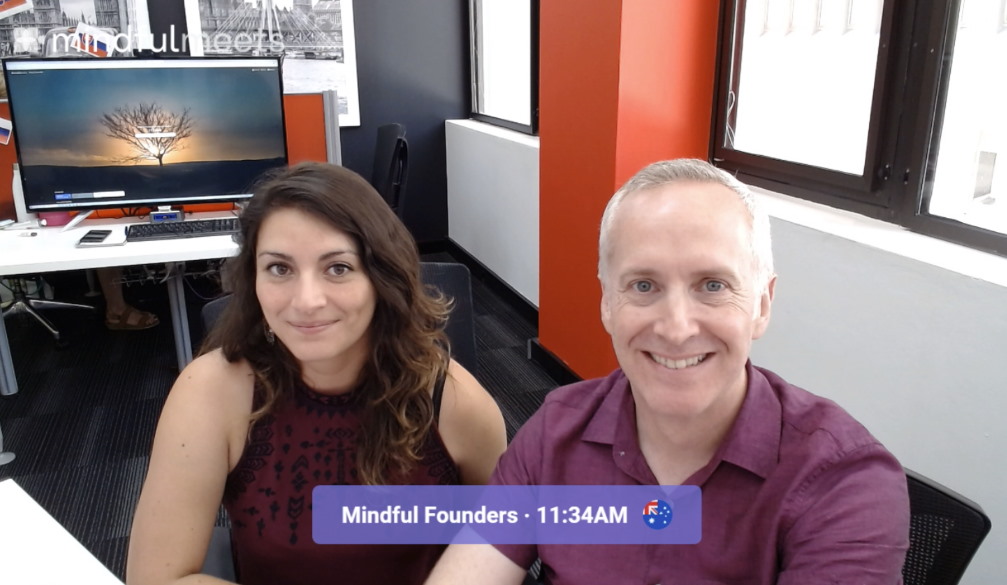Aussie small business owner fights global Zoom fatigue with new tech
- Written by Elevate

Stuck in back-to-back meetings and need the loo? A Brisbane start-up has the antidote for your work from home (WFH) woes, including a clever video loop (“On Hold”), so you can sneak away from your Zoom calls without anybody realising.
With more than 18 years in the tech space, tech developer and Co-Founder Ben Flux created the Mindfulmeets app with Co-Founder Karina Castex, after seeing their colleagues struggle with prolonged screen time during the pandemic.
The world-first free Chrome browser extension, designed to enhance video calls with a slew of mindful features, now has 3,000 users around the world, including the US where half the population continue working from home.
“Having a tech team situated globally, we were needing to navigate different time zones, varying lifestyles and the day-to-day realities of working remote,” Mr Flux said.
“I started to think of ways to simulate the in-person interactions we had been missing, that help us survive the workday; shaking hands, clowning around and showing a bit of comradery. We need technology that considers the way we operate and live as humans as well as the value of time.”
Features include the ability to record a short video loop, so you can appear present while you grab a coffee or answer the door – perfect for a quick and much-needed moment away.
Mindfulmeets can also create virtual agendas to keep discussions focused or send reminders to ensure meetings don’t overrun.
Importantly, Mr Flux said the extension allowed users to break through awkward silences with emojis and GIFs.
“Without face-to-face interactions, we’re seeing an increase in people feeling overwhelmed, irritable and anxious – presenting a challenge to most modern workplaces,” said Ms Castex.
“While a free and simple to download extension won’t address all the impacts, we know Mindfulmeets will make a difference to the digital wellness of users.”
Research conducted by Mindfulmeets to identify the top frustrations experienced by remote working revealed overrun and unstructured meetings, the lack of quality social interaction and the quantity of meetings were key pain points.
With video conferencing established as a new norm, the reality of mental fatigue poses a real threat to the mental health of users and the productiveness of businesses and education providers.
The inability to read body language cues, intense focus on conversation and sustained eye contact are key factors contributing to the mental exhaustion.
Susan Long, registered Psychologist and Clinical Services Manager with Workplace Wellness Australia - a leading provider of proactive employee assistance programs - agrees that a mentally healthy workplace recognises the unique needs of its employees.
“Moving to working online and offsite from the physical workplace increased a sense of isolation and aloneness for many people,” said Ms Long.
“Our sense of connection and feeling heard is often related to eye contact and physical social interactions. This can be difficult to maintain when there are a number of participants in an online meeting. Without the reinforcement of connection through eye contact, the brain needs to work harder than it would typically in a face-to-face interaction causing people to feel fatigued.
“For many workplaces, the move to online highlighted the importance of checking in with their colleagues and employees who lived alone or were isolated. The pandemic caused many workplaces to relate to their peers and consider how each other were going.
“Staying well is important to work effectively and workplaces that can introduce a more psychologically appropriate format of how meetings progress are invaluable.”
Mindfulmeets is available to download now and is compatible with Zoom, Microsoft Teams and Google Meet.
The extension currently includes the capability to:
- “On Hold” feature, letting you create a video loop so you can step away from the keyboard;
- Add an agenda to a meeting;
- See the profile of all attendees (including name and position);
- Share emojis and gifs;
- See the time zones of each attendee, and
- Gracefully exit and enter meetings with helpful prompters visible to everyone on the call
To download the free extension, visit: https://www.getmindfulmeets.com/
















